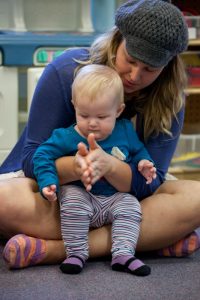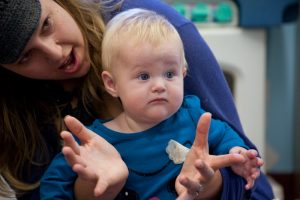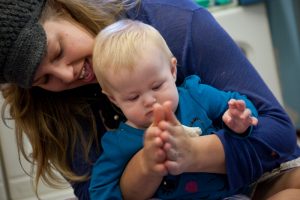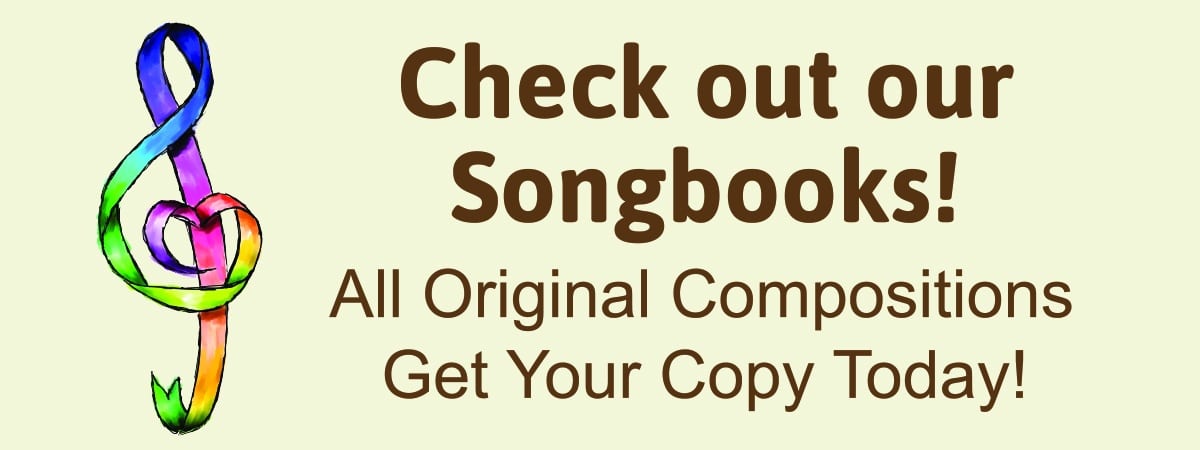I can’t believe that I was so sloppy in researching just how important clapping is to children and to all people! Just recently, I was trying to explain to a new intern how and why children clap. Of course I told her that I would send her some links to literature on early clapping from my previous writing. Guess what? There was nothing there! Yes, there were some references about when it should happen and lots of ideas of clapping interventions, but I glossed over clapping as if it were just another on the list of markers of early childhood development. Whoa! The children and families I work with use clapping as the ‘go-to’ musical response –way before they are willing or able to sing or play an instrument. How could I have been so blind to how important clapping is?
I felt a little better after doing a search of scholarly articles on clapping. Although my exploration was certainly not thorough, I couldn’t find the comprehensive neurological, physical, cognitive, emotional and social overview of clapping that I was hoping to find. So here are some thoughts about clapping as a vital human response. While I think about clapping within a musical context, clapping is about so much more- it is about the development of ‘self’. It helps me to think in categories so here are the four areas of clapping that I think of most with small children- Containment, Communication, Celebration and Community.
Containment
Infants come into the world wired to absorb. From the first, they take in sounds and smells and sights. The problem is that early on babies have few mechanisms to shut off the flow of experiences. When babies fuss or cry, it is often because they don’t have a way to understand or change the stuff that is thrown their way, whether it is a wet diaper or a great Aunt who comes just a little too close. It takes much of the infant’s first year for their body and mind to begin to gel into one operating system. A signal that they are starting to understand the boundaries of their body comes when the infant brings their palms together, and then begins to practice the movement which is the precursor of clapping. The sensitivity of the palms touching provides a way for the body to connect with itself. The baby starts to sense the line that defines themselves. Try really focusing while putting your palms together and see how it feels. It is no wonder that many of the world’s spiritual or religious movements use the palm-together gesture as a way to concentrate on deeper thoughts. I see many children with special needs use hand wringing or clapping in a way that makes me think that they are trying to find or define themselves. Independently using clapping as a way to contain can be very important in developing a healthy ‘self’.
Communication
Clapping is an outward gesture that we can see and feel and hear. So while clapping might start as helping a child with containment, it soon begins to take on meaning that other people can recognize. Spend time with a new family and you will hear the oohs and aahs when the new baby first smiles and first claps their hands. It is almost as if we need to see and hear these gestures to really believe that there is a ‘person’ inside. Babies soon begin to recognize that grownups respond when they bring their hands together. As the child grows and starts to make sounds with clapping they use the gesture to show pleasure or to get attention.
Adults also use clapping to communicate with children. A little one takes a first step, the grownup claps. They finish the food on their plate, and the grownup claps. The sound of clapping can also communicate a different message very clearly. I remember my mother who raised eight children without ever raising her voice. How did she let us know when she was displeased? A very loud sharp clapping sound that could be heard above the din of even the noisiest of days.
Celebration
How did clapping become the way we celebrate? We clap to show appreciation, we clap at important events, we clap at concerts, and we clap at the end of movies. Why? In trying to answer that question, I found very little in the literature except to say that that is what humans do. When I observe young children, though, I think I can see where it comes from. When something excites us or moves us, our brain signals our bodies to express that excitement or stimulation. I think that clapping started as a way to let the energy out when our brains can no longer keep it in. Similar to dancing or jumping, clapping is a way to expel and dissipate energy.
For very young children, clapping can be a physical indication of intense emotions that they are not ready to express in other ways such as using words. Clapping as a unique gesture generally begins in the second half of the child’s first year. For the next few years, the child will clap sporadically and often non-rhythmically. It feels very spontaneous and seems to me to support that gesture as being a physical release. However, when I see little ones bringing their hands together in carefree and joyous movements, I can’t but help celebrate life!
Community
Of the studies on clapping that I found, the use of clapping to support a sense of community and belonging was the most researched. I think I can now safely say that there is strong scientific evidence that synchronous movement is directly connected to social bonding. Clapping, along with dancing, might be the most ubiquitous synchronous movement in our current culture. Try ‘googling’ clapping and you will see page after page linking clapping to social, artistic, religious and sports gatherings.
For young children, the instinctual clap that starts as bringing the palms together gradually grows by about age four or five into the ability to clap in unison with others. They can control their gestures to make a musical sound and regulate the tempo to join in with everyone else. Through the clapping they become part of a community.
So I will go back to work with a renewed respect for all the stages and meanings of clapping for my young music makers and their families. And yes, I will probably clap for myself that I finally woke up to a better understanding of the seemingly simple gesture of clapping.
Enjoy clapping to the music!
Beth
P.S. Visit http://sproutingmelodies.com/2016/07/14/im-so-glad-to-be-me/ for a brand new song I wrote about the joy of clapping.


